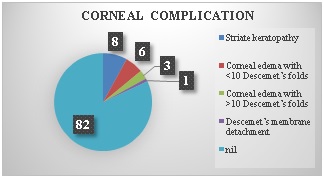A prospective study on corneal complications of small incision cataract surgery conducted in rural hospital
Abstract
Aim: To study various corneal complications in manual small incision cataract surgery (MSICS), to study the risk factors leading to such complication and to study the final visual outcome following complications.
Design:It is a prospective hospital based observational study.
Methodology: In our study 100 eyes of 100 patients were studied who underwent MSICS with posterior chamber intraocular lens implantation. Corneal complications, their risk factors and final visual outcome were studied on post operatively day 1, day 8 and 6th week after surgery.
Results: One hundred eyes of 100 patients who underwent MSICS were studied. Corneal complications were seen in 18% of patients. Of these 8% developed striate keratopathy, 6% developed corneal edema with <10 Descemet’s folds, 3% developed corneal edema with >10 Descemet’s folds, 1% developed Descemet’s membrane detachment. 94% of the patients categorized under good visual outcome category (BCVA better than 6/12), 89% had best corrected visual acuity (BCVA) of 6/9 or better at the end of 6th postoperative week.
Conclusion: MCIS is associated with few corneal complications which cannot be overlooked. With appropriate management, most of the corneal complications will be resolved by 2nd postoperative week. Vigilant attitude by the surgeon and timely management can reduce such complications and help in early visual rehabilitation.
Downloads
References
2. Park K. Parks text book of preventive and social medicine: Health Programmes in India. 22nd edition. Jabalpur: m/s Banarsidas Bhanot Publishers; 2013.p.405-8.
3. Kershner RM. Sutureless one-handed intercapsular phacoemulsification. The keyhole technique. J Cataract Refract Surg. 1991;17 Suppl:719-25.[pubmed]
4. Gogate P. Comparison of various techniques for cataract surgery, their efficacy, safety, and cost. Oman J Ophthalmol2010;3:105-6.
5. Gogate PM, Kulkarni SR, Krishnaiah S, wt al. Safety and efficacy of phacoemulsification compared with manual small-incision cataract surgery by a randomized controlled clinical trial: six-week results. Ophthalmology. 2005 May;112(5):869-74. DOI:10.1016/j.ophtha.2004.11.055.[pubmed]
6. Holladay JT, Cravy TV, Koch DD. Calculating the surgically induced refractive change following ocular surgery. J Cataract Refract Surg. 1992 Sep;18(5):429-43.[pubmed]
7. Hwang DG, Smith RE. Corneal complications of cataract surgery. Refract Corneal Surg. 1991 Jan-Feb;7(1):77-80.[pubmed]
8. Lumme P, Laatikainen LT. Risk factors for intraoperative and early postoperative complications in extracapsular cataract surgery. Eur J Ophthalmol. 1994 Jul-Sep;4(3):151-8.[pubmed]
9. Sudhakar J, Ravindran RD, Natchiar G. Analysis of complications in 1000 cases of posterior chamber intra ocular lens implantation. Indian J Ophthalmol. 1989 Apr-Jun;37(2):78-9.[pubmed]
10. Venkatesh R, Das M, Prashanth S, et al. Manual small incision cataract surgery in eyes with white cataracts. Indian J Ophthalmol. 2005 Sep;53(3):173-6.[pubmed]
11. Gogate PM. Small incision cataract surgery: Complications and mini-review. Indian J Ophthalmology 2009 Jan-Feb;57(1):45-9.[pubmed]
12. Kanski, Jack J. Clinical ophthalmology: a systematic approach: Management of age-related cataract. 6th edition. Edinburgh; Elsevier Butterworth-Heinemann; 2007.p.360.
13. Baltussen R, Sylla M, Mariotti SP. Cost-effectiveness analysis of cataract surgery: a global and regional analysis. Bull World Health Organ. 2004 May;82(5):338-45.[pubmed]
14. Baltussen R, Sylla M, Mariotti SP. Cost-effectiveness analysis of cataract surgery: a global and regional analysis. Bull World Health Organ. 2004 May;82(5):338-45.

Copyright (c) 2019 Author (s). Published by Siddharth Health Research and Social Welfare Society

This work is licensed under a Creative Commons Attribution 4.0 International License.


 OAI - Open Archives Initiative
OAI - Open Archives Initiative



















 Therapoid
Therapoid

